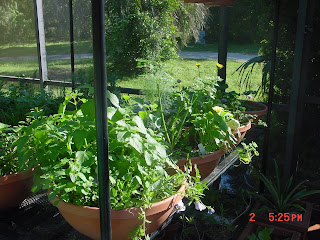As climates, pests and plant diseases change, so too the chemicals on our food. Large-scale farmers fight a constant battle to produce blemish-free fruits and vegetables with shelf lives long enough for the transport of food thousands of miles to our grocery stores. It's quite a phenomenal feat really.
The purpose of my book -- now updated with the new name, Organic Container Gardening--Grow Pesticide Free Fruits and Vegetables in Small Spaces -- has never been to bash the farmer. Their job of feeding millions for a small renumeration is hard enough! But I do want to feed my family fewer chemicals so I take the Environmental Working Group's list of foods that are high in pesticide residues seriously. By growing the fruits and vegetables from the list my family eats most commonly, I can reduce the chemicals in our diet, enjoy more nutritious produce and save a little money at the grocery store.
"FreshLife Organic Garden Mix Sprouting Seeds" (Google Affiliate Ad)
The truth is, no one knows how the chemicals from one fruit or vegetable will interact with those from another food in our bodies. No one really knows if chemicals -- designed to cause nerve or other damage to pests -- will build up in our bodies and cause cancers or other illnesses, though there is some research in children to support this theory.
We can't grow all the foods we eat ourselves, but we can grow those we eat most commonly, particularly those we know are high on the list of the most contaminated fruits and vegetables, aka "the dirty dozen". The Dirty Dozen is the 12 Fruits and Vegetables with the highest pesticide residues AFTER they have been "washed and prepared for eating", according the USDA/FDA studies.
Organic Container Gardening details how to grow "the dirty dozen", including the two newest members of this notorious club, Kale and Blueberries. We're pleased the book has been well reviewed and believe it truly has helped home gardeners grow organic produce in containers.
The new dirty dozen list, from most contaminated to least, is as follows:
Apple
Celery
Strawberries
Peaches/Nectarines
Spinach
Grapes
Sweet Bell Peppers
Potatoes
Blueberries
Lettuce
Kale
"2.75 Lbs Organic Traditions Garden Manure 4-2-2" (Google Affiliate Ad)
The purpose of my book -- now updated with the new name, Organic Container Gardening--Grow Pesticide Free Fruits and Vegetables in Small Spaces -- has never been to bash the farmer. Their job of feeding millions for a small renumeration is hard enough! But I do want to feed my family fewer chemicals so I take the Environmental Working Group's list of foods that are high in pesticide residues seriously. By growing the fruits and vegetables from the list my family eats most commonly, I can reduce the chemicals in our diet, enjoy more nutritious produce and save a little money at the grocery store.
"FreshLife Organic Garden Mix Sprouting Seeds" (Google Affiliate Ad)
The truth is, no one knows how the chemicals from one fruit or vegetable will interact with those from another food in our bodies. No one really knows if chemicals -- designed to cause nerve or other damage to pests -- will build up in our bodies and cause cancers or other illnesses, though there is some research in children to support this theory.
We can't grow all the foods we eat ourselves, but we can grow those we eat most commonly, particularly those we know are high on the list of the most contaminated fruits and vegetables, aka "the dirty dozen". The Dirty Dozen is the 12 Fruits and Vegetables with the highest pesticide residues AFTER they have been "washed and prepared for eating", according the USDA/FDA studies.
Organic Container Gardening details how to grow "the dirty dozen", including the two newest members of this notorious club, Kale and Blueberries. We're pleased the book has been well reviewed and believe it truly has helped home gardeners grow organic produce in containers.
The new dirty dozen list, from most contaminated to least, is as follows:
Apple
Celery
Strawberries
Peaches/Nectarines
Spinach
Grapes
Sweet Bell Peppers
Potatoes
Blueberries
Lettuce
Kale
"2.75 Lbs Organic Traditions Garden Manure 4-2-2" (Google Affiliate Ad)



